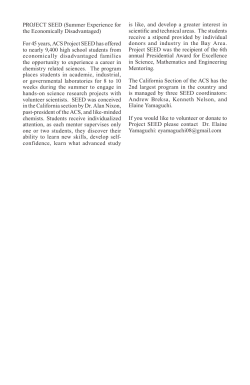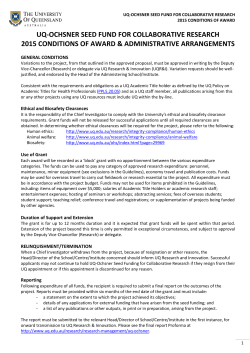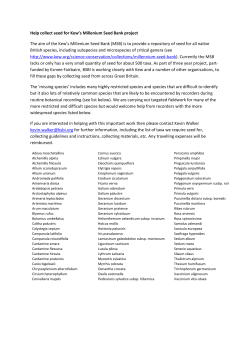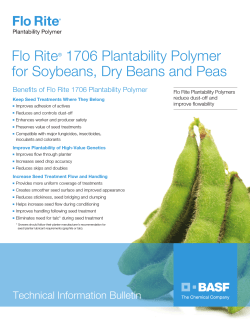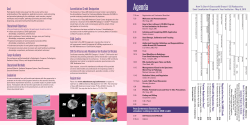
two wheel tractor newsletter - Conservation Agriculture Knowledge
TWO WHEEL TRACTOR NEWSLETTER - MARCH 2015 Report on FACASI meeting – Mid February 2015. (Part of an AIFSRC/ACIAR funded CIMMYT-led project.)* Delegates from the four East African nations being covered in the current FACASI project met in Addis Ababa in mid-February, as part of a mid-term review of the project. Various administrators and coordinating staff were also present. The aim of the meeting was to review progress, and plan strategies for the next part of the project. Several key points arose from the discussions. A review of the useful and poor features of each seed drill tested in the past year was discussed. Some seed drills have proved to be basically sound, whilst others have to varying degrees inadequate characteristics which in some cases make them very difficult in reality to recommend to the East African farmer. Also, it was apparent that much more needs to be done in the field of practical training and instruction. Initially this is for the key staff associated with the project, and through them to others, and ultimately to farmers and operators who will use the tractors and seed drills. Various ‘trainers’ including Joseph Mutua, Scott Justice and, Jeff Esdaile have conducted training workshops in Zimbabwe, Tanzania, Kenya, and Ethiopia in the last year. However it seems clear that many more persons need to be trained in the setup, maintenance and operation of this equipment. As well, in order to carry out these tasks more effectively in the future, some simple and readable booklets are being produced. The first is a brochure showing the main features of each seed drill being evaluated. The second is a simple and readable operator manual outlining the procedure for set-up of the seed drill, as well as instructions for the operation of each unit. Such topics as calibration of seed and fertiliser, row spacing, depth of planting and seed covering are being addressed. Additionally, a simple service manual for 2WT is being generated. *(Australian International Food Security Centre – Australian Centre for International Agricultural Research – International Maize and Wheat Improvement Centre - Farm mechanisation and conservation agriculture for sustainable intensification) ================================================== Consultations with Engineering Dept. University of Southern Queensland (USQ) Feb. 2015 In late February the 2WT along with the near complete prototype of the Gongli Africa Mark 2 were taken to USQ for opinions on the way forward to resolve some of the outstanding challenges in the design of the seed drill. Of particular interest is the final strategy for the mechanical lift system of the unit. The current rope trip lift arrangement (see previous newsletters) from the 65 year old seed drill is barely adequate. It is too big and too heavy, and as well cannot exert positive pressure on the soil engaging tools (tines or discs) to hold them in the soil at the correct depth. Participants in the 2WT seeder design discussion group at USQ Toowoomba From left: Jeff Esdaile (fabricator) Clive Murray (Syngenta Foundation) Amy Brumpton (student) Prof. John Blackwell (Charles Sturt Uni.) Prof. Guangnan Chen (USQ & student supervisor) Absent: Jeff Tullberg. Final year USQ Mech. Eng. Student Amy Brumpton has taken on the job of designing and/or locating a suitable compact simple mechanical lift system which will properly raise and lower the tines, and also hold them in the ground correctly when the machine is operating. As well as mechanical lift methods, possibly an alternative suitable manual lift can be designed, or maybe a hydraulic set-up. At left: John Blackwell (seated) discusses some of the challenges in 2WT seed drill design with others at USQ. Another issue is the re-design of the down pressure spring assemblies for the soil engaging tools. There is limited space between the base of the seed boxes, and the location of the tine assemblies in the raised position. A compact assembly is being constructed which will allow the tines to freely operate unhindered under the seed boxes, and yet allow the seed metering system to deliver seeds and fertiliser down the delivery tubes without any restraints. The original tine mechanism with elevated spring (left) and the re-designed compact spring system (right) Fortunately there is an experienced spring manufacturer in the Toowoomba district who fabricates springs for most farm implement manufacturers in SE Queensland and N. New South Wales. I am confident that an appropriate compact tine assembly incorporating a suitable down pressure spring will eventually result from the newer version. ============================================= Can an ARC Gongli 2WT seed drill successfully plant rice directly into a flooded field? Craig Birchall (a lecturer from University of New England, Armidale, Australia,) has an Australian aid project on crop production and small farm mechanisation in Myanmar. Some other NGO’s are also participating. Various Chinese 2WT seed drills have been imported for evaluation. Some enterprising colleagues have attempted to direct seed rice into a flooded field, with the ARC Gongli seed drill. What do you think? From the limited details available from these pictures I can deduce the following. First - the seed drill has been assembled correctly. Second - rubber press wheels are not ideal for use in flooded fields. Third – a tail wheel with seat is not much good either. My recommendation would be: Replace the rubber press wheels with steel spoke wheels of appropriate dimension. (Or maybe some sort of full width slotted steel cage type roller) Raise the tines up to around or just below the water level- pull the seed tubes from the seed boots and drop the seeds aerially into the mud. The tines then are only acting as locators to ensure straight seed rows. The steel cage assembly on the rear would then press the seeds into the soil. Any other ideas? (Once again the proper training of operators in new situations may be necessary.)-Ed ============================================= Mini Happy Seeder for 2WT prototype now being tested in India. The CIMMYT-BISA* team working in Ludhiana led by Dr. H.S. Sidhu have developed the first prototype of MHS (Mini Happy Seeder) for 2WT with the support & collaboration of Dasmesh Mechanical Works Amargarh. The preliminary testing gave very encouraging results and detailed testing and evaluation is now in progress at the BISA research farm near Ludhiana. Many local and international research workers have been involved including Dr. M L Jat, Er Manpreet and the CIMMYT-BISA team assisted by Ken Sayre, Scott Justice, Jelle Van Loon and Dr. Raj Gupta. Modern forms of the Happy seeder (including this mini version) have a modified flail setup compared to older units. As well as chopping the old crop residue into pieces in the sowing strips, the flails are positioned so that they act as tine cleaners to keep excess residue from building up around the tines. *BISA – Borlaug Institute for South Asia The prototype mini ‘Happy’ seeder for 2WT. =========================================== If you have any comment on this newsletter, please let us know. Back issues of the 2WT Newsletter can be found at :http://conservationagriculture.mannlib.cornell.edu/pages/resources/twowheel.html Note: This newsletter has been sent in a low resolution pdf. format for those on slow internet connections. If you require the newsletter or parts of it in higher resolution please let me know. R. J. Esdaile, Agricultural Consultant, 22 Meadowbanks Drive, TAMWORTH NSW 2340 Australia. Email: rjesdaile@bigpond.com rjesdaile@gmail.com (alternate) E. & OE.
© Copyright 2025

